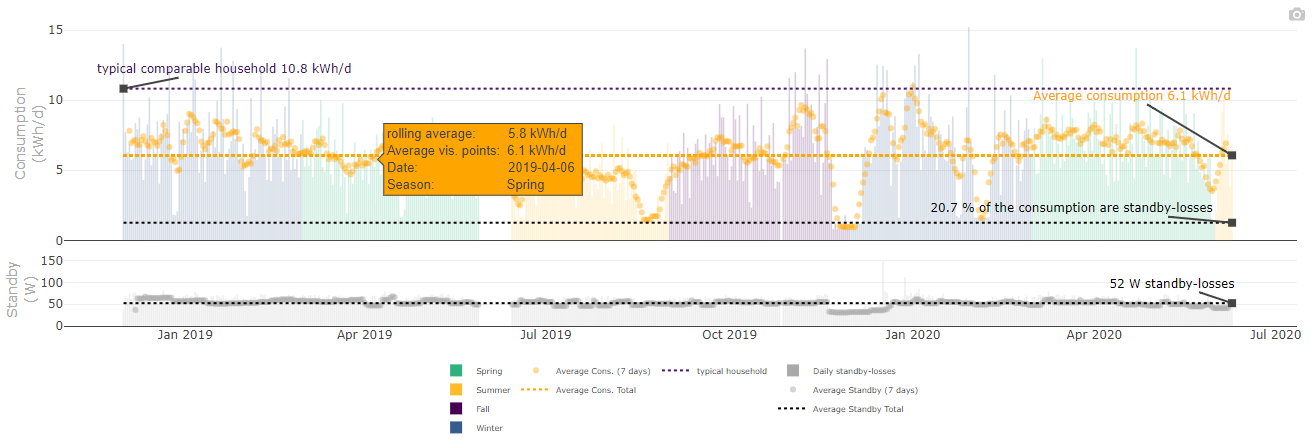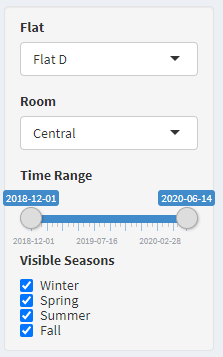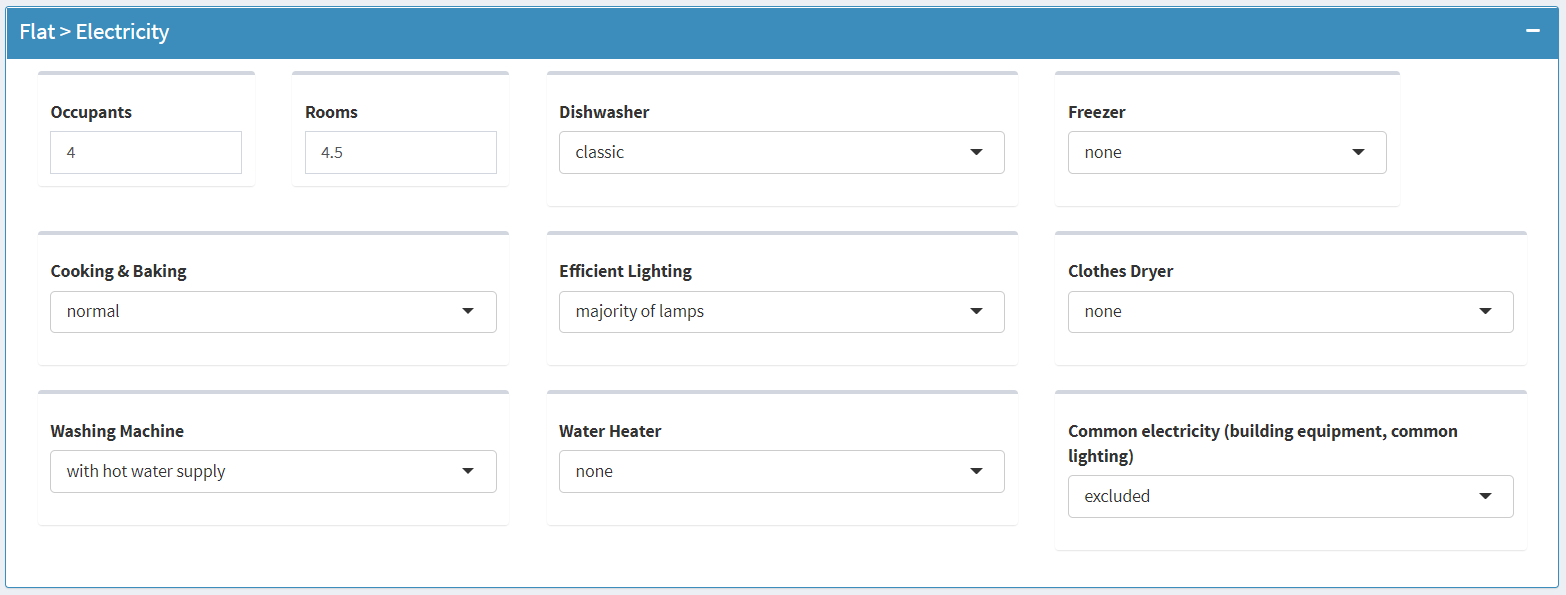Visualization(s)
Daily Electric Energy Consumption and Standby Power
A simple overview of the time series data per room.

- The chart is splitted in two subplots:
- upper plot with daily energy consumption in kWh/day
- lower plot with standby-losses in Watts
- The points represent a rolling mean value of the last seven days
- The solid dashed lines represent the total mean value of the visible points. On the right are two text annotations with the values of these two lines.
- A horizontal line with a left aligned annotation shows a typical houshold for comparison. Calculated with extended settings (described below). Formulas and values from [1]
- Tooltip: Place the mouse pointer over a datapoint to get more information of a specific measurement.
Settings
Basic

Flat and Room
- Selection of flat resp. room which should get analyzed.
- According to the building hierarchy all flats and rooms get listet which have a datapoint of type “tempRoom” or “humRoom”.
Time Range
- The date left is automatically the oldest timestamp and on the right side the newest.
- Narrow the time range to make comparisons.
Visible Seasons
- The points are colored according to the season.
- With the checkboxes the measurements of a season can be shown and hidden individually.
Extended
- To access the extended settings, the plus symbol in the upper right corner of the title bar must be pressed.
- Per default the extended settings tab is collapsed.
- All the settings below are used to calculate the “typical household” consumption.
- Please note that you only have to select devices that are really connected to the corresponding electric meter.

- Depending on the setting and
Settings > App Configuration > Building Typethe typical consumption changes. - For detailed values, bachground information and formulas see [1]
- Adaptions of the extended settings does not (yet) get changed.
Occupants
- Default value comes from
Settings > Building Hierarchy > occupants - The persons should be present at least on working days, i.e. at least in the evening and usually for 2 meals.
- Children up to approx. 10 years are to be counted as approx. “½ person”.
- Teenagers from about 11 years on are to be counted as adults.
Rooms
- If the effective room number deviates significantly, i.e. by more than 1, from a “typical room number”, the typical energy consumption is adjusted accordingly.
Dishwasher
- none: no dishwasher powered with this meter
- classic: dishwasher available, no further classification
- with hot water supply: electrical dishwasher which uses as well hot water to heat up
Freezer
- none: no “big” freezer powered with this meter. The one in the refrigerator does not count.
- classic: additional freezer available, no further classification
Cooking & Baking
- If cooking and baking is particularly intensive and often, and little hot food is eaten outdoors, this increases the base value by 50 per person.
- Conversely, if the stove and oven are used less intensively and food is eaten outdoors frequently, this reduces the base value by 50 per person.
Efficient Lighting
- The mix values apply to a share of efficient lamps of about 40 to 50% (energy saving lamps, LED, fluorescent tubes).
- Attention: Halogen or “Eco-Halogen” lamps are not efficient!
- Majority means more than 80%, minority less than 20%
Clothes Dryer
- none: no dryer powered with this meter
- room air dryer: room air dehumidifier in the drying room
- heat pumpt dryer: dryer with integrated heat pump, uses less energy than classic one!
- classic dryer: classical one which is only connected to the electric power
Washing Machine
- none: no washing machine powered with this meter
- classic: washing machine available, no further classification
- with hot water supply: electrical washing machine which uses as well hot water to heat up
Water Heater
- none: no water heater powered with this meter
- Electric Boiler: separate electric boiler powered with this meter
- Heat Pump: only for single family houses when the water heater is connected to the meter
Common electricity (building equipment, common lighting)
- included: e.g. for single family houses with main meter
- excluded: e.g. for multi family houses where the meter of the flat gets analyzed. Normally the common electricity is measured by a separate meter.
References
[1] Nipkov, J. (2013). Typischer Haushalt-Stromverbrauch. Schlussbericht. Bundesamt für Energie (BFE). https://www.aramis.admin.ch/Default.aspx?DocumentID=61764